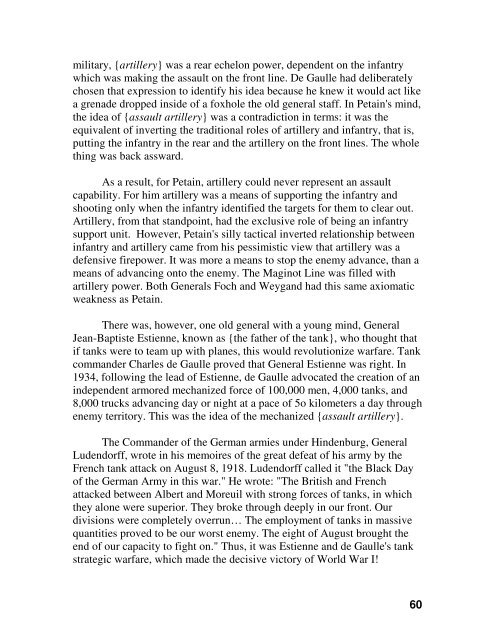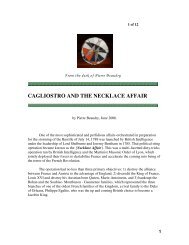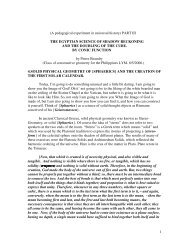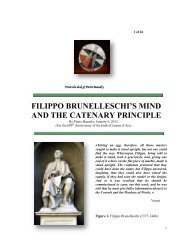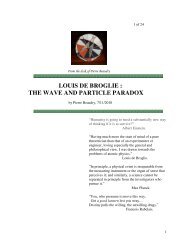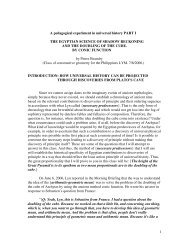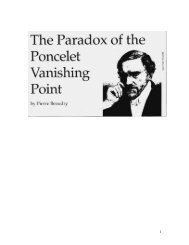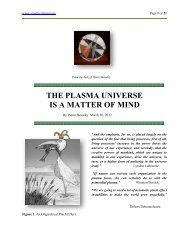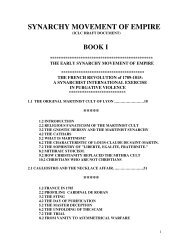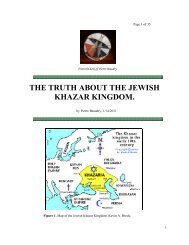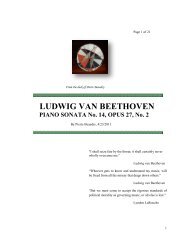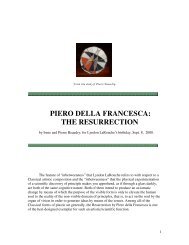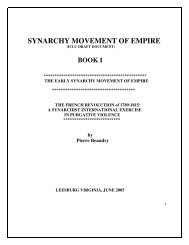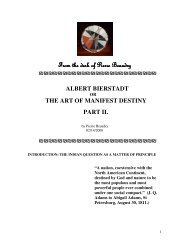synarchy movement of empire book ii - Pierre Beaudry's Galactic ...
synarchy movement of empire book ii - Pierre Beaudry's Galactic ...
synarchy movement of empire book ii - Pierre Beaudry's Galactic ...
You also want an ePaper? Increase the reach of your titles
YUMPU automatically turns print PDFs into web optimized ePapers that Google loves.
military, {artillery} was a rear echelon power, dependent on the infantry<br />
which was making the assault on the front line. De Gaulle had deliberately<br />
chosen that expression to identify his idea because he knew it would act like<br />
a grenade dropped inside <strong>of</strong> a foxhole the old general staff. In Petain's mind,<br />
the idea <strong>of</strong> {assault artillery} was a contradiction in terms: it was the<br />
equivalent <strong>of</strong> inverting the traditional roles <strong>of</strong> artillery and infantry, that is,<br />
putting the infantry in the rear and the artillery on the front lines. The whole<br />
thing was back assward.<br />
As a result, for Petain, artillery could never represent an assault<br />
capability. For him artillery was a means <strong>of</strong> supporting the infantry and<br />
shooting only when the infantry identified the targets for them to clear out.<br />
Artillery, from that standpoint, had the exclusive role <strong>of</strong> being an infantry<br />
support unit. However, Petain's silly tactical inverted relationship between<br />
infantry and artillery came from his pessimistic view that artillery was a<br />
defensive firepower. It was more a means to stop the enemy advance, than a<br />
means <strong>of</strong> advancing onto the enemy. The Maginot Line was filled with<br />
artillery power. Both Generals Foch and Weygand had this same axiomatic<br />
weakness as Petain.<br />
There was, however, one old general with a young mind, General<br />
Jean-Baptiste Estienne, known as {the father <strong>of</strong> the tank}, who thought that<br />
if tanks were to team up with planes, this would revolutionize warfare. Tank<br />
commander Charles de Gaulle proved that General Estienne was right. In<br />
1934, following the lead <strong>of</strong> Estienne, de Gaulle advocated the creation <strong>of</strong> an<br />
independent armored mechanized force <strong>of</strong> 100,000 men, 4,000 tanks, and<br />
8,000 trucks advancing day or night at a pace <strong>of</strong> 5o kilometers a day through<br />
enemy territory. This was the idea <strong>of</strong> the mechanized {assault artillery}.<br />
The Commander <strong>of</strong> the German armies under Hindenburg, General<br />
Ludendorff, wrote in his memoires <strong>of</strong> the great defeat <strong>of</strong> his army by the<br />
French tank attack on August 8, 1918. Ludendorff called it "the Black Day<br />
<strong>of</strong> the German Army in this war." He wrote: "The British and French<br />
attacked between Albert and Moreuil with strong forces <strong>of</strong> tanks, in which<br />
they alone were superior. They broke through deeply in our front. Our<br />
divisions were completely overrun… The employment <strong>of</strong> tanks in massive<br />
quantities proved to be our worst enemy. The eight <strong>of</strong> August brought the<br />
end <strong>of</strong> our capacity to fight on." Thus, it was Estienne and de Gaulle's tank<br />
strategic warfare, which made the decisive victory <strong>of</strong> World War I!<br />
60


